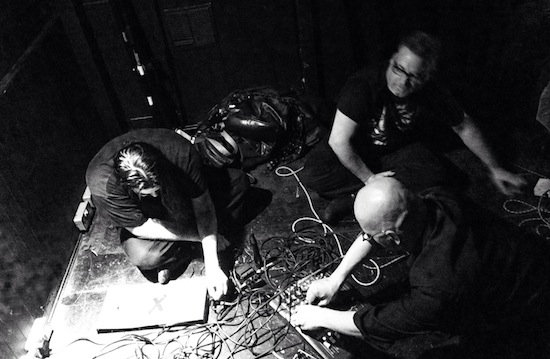Richard Ramirez, seemingly in the interest of transparency, outlined Black Leather Jesus’ (BLJ) Kickstarter-funded European tour as "intended only to pay for transportation and incidentals once we arrive. The individual members of the group are 100% responsible for paying their way to get there. That is a major up-front expense and, while we are hoping the maximum number of members will be able to raise enough for their flights, and to sustain themselves on the road, we cannot promise how many will make it." The fact that only three members of Black Leather Jesus’ constantly cycling line-up are present at Ryan’s Bar last Friday speaks of an ever-escalating inability to offer live noise/power electronics to a foreign fan base, whilst simultaneously underscoring Ramirez and the band’s desire and dedication towards such transatlantic touring.
Operative since 1989, Black Leather Jesus have fashioned an approach towards noise music that sits somewhere between the recently resurgent trend of harsh noise wall soundscapes and more traditionally syncopated/pummelling power electronics; utilising contact mics in combination with scrap metal percussion to produce a sound that is in a constant state of flux, existing between static arrhythmia on one hand, and purely primal bone-bashing rhythm on the other. Traditional Black Leather Jesus performances – often comprising of a 10+ strong cohort – offer the audience a physical and visual (plus obvious sonic) overload.
Far removed from the Merzbow-influenced lineage of laptop noise, Jesus have always been keen to maintain a live front that contextualises the physical collectiveness inherent in their work. It could be argued that the pared-down line-up present at Ryan’s Bar maintain less of a performative visual punch; however, being only three-strong seems to allow Ramirez and friends to offer a purer distillation of the band’s musical constructionism.
The threesome maintain seated/kneeling positions throughout the thirty-five minute performance, on a stage that is only marginally higher than the rest of the venue. Where a Black Leather Jesus performance might traditionally offer the aforementioned outward physical projection, the band tonight seem locked into their pedals, circuits and contact mics. The percussive scrap metal that usually spreads across the stage is much reduced, and it is in fact the stage itself that becomes the primary source of sonic interest for Ramirez. Rubbing a contact mic between two wooden floorboards offers a tonality that seems instantly more organic/acoustic than the tones created on BLJ’s releases. Such striving for organic sounds is taken to its logical extreme when members of the audience begin to offer themselves up to be played – a nice intimacy develops.
This is the central strength of Black Leather Jesus’ live performances; a repudiation of the traditionally held notion that live HNW and PE must be based around some kind of radical posturing (be it a particular physical/verbal/sexual confrontation). Black Leather Jesus almost manage to exist as a collective beyond their cycle of performers, making everyone they touch (be it audibly or with contact mics) part of their extremely positive and noisy outlook.


